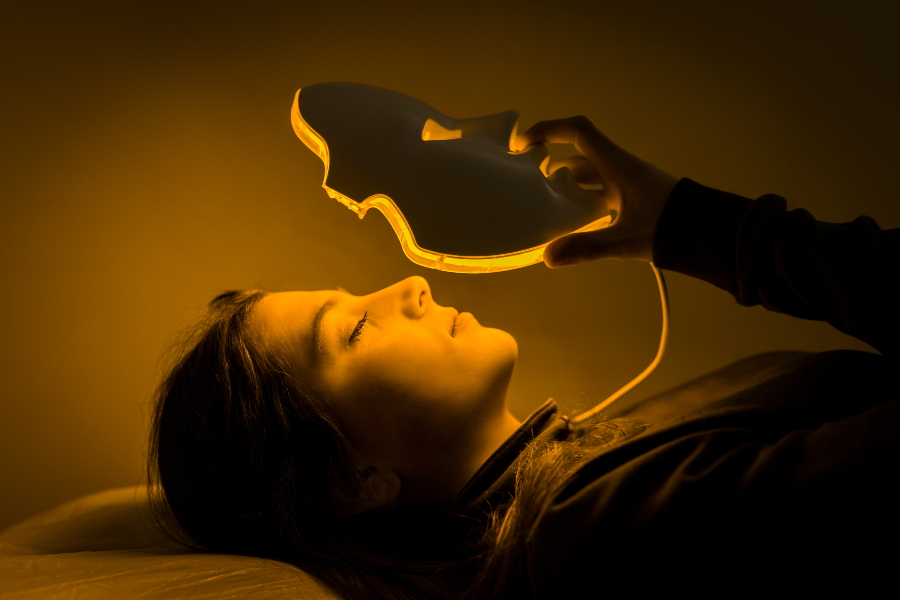Using an At-Home LED Face Mask? Here’s What You Need to Know
We asked Philly-area estheticians all about at-home light therapy devices — and if the trend is more than just skin-deep.

LED light therapy can yield a number of skin benefits. Local estheticians dish the truth about using an at-home LED mask. / Photograph via Getty Images.
If you’ve scrolled Instagram or TikTok recently, you’ve likely stumbled upon at least one person wearing a color-emitting face mask. No, they aren’t prepping their Friday the 13th Halloween costume; they’re trying to get glowing skin in the comforts of their own home.
LED (light-emitting diode) light therapy is a non-invasive treatment in which a person’s face is exposed to and absorbs different wavelengths of light for supporting collagen production, reducing inflammation, and the like. Once exclusive to spas and skincare centers, LEDs have now become more mainstream and accessible, thanks to at-home devices — and all the celebs using them. (Hello, Emily in Paris season three, episode one!)
Because at-home LED masks have quickly become cult classics in the beauty world, we turned to three Philly-area estheticians to see if the trend is more than just skin-deep. Below, find insight from Viviane Aires, owner of Viviane Aires Skin Wellness; Jena Salzano, owner of Anej Skin Studio; and Jewellee Williams, owner of Crown Jewel Esthetics.
Be Well Philly: What are the benefits of LED therapy?
Aires: As we age, the ability of our cells to produce energy diminishes, but light therapy increases cellular energy. It can also increase the skin’s hydration and reduce sun damage, such as brown spots and hyperpigmentation, by promoting cellular turnover and boosting collagen production.
The most used light therapies are red and blue light. The former will be better for anti-aging purposes because it helps to increase collagen production, which in turn can reduce the appearance of fine lines and wrinkles. Red light can also help to improve skin texture and tone by increasing blood flow and oxygenation to the skin cells. This helps to nourish the skin and improve overall complexion. Blue LED light therapy has anti-inflammatory properties, which can help to reduce redness, swelling, and inflammation associated with acne and other skin conditions.
Salzano: There’s also yellow light, which helps with lymphatic flow to clear toxins, and green light works well for brightening the skin when used with active ingredients on the epidermis.
Generally, how often and for how long should the skin be exposed to LED?
Williams: LED can be used three to four times a week for approximately 15 to 25 minutes for a whole-face treatment. However, best results will come from combining home treatments with professional facials that incorporate LED because licensed professionals have access to devices that emit a stronger output of light.
[Ed. Note: Aires recommends three to five times per week for about 15 minutes, and Salzano suggests three times per week for 20 to 25 minutes or five days per week for 10 minutes.]
What skin types should avoid LED light therapy?
All three experts agree that LEDs are good for all skin types. Williams adds that you should consult with your doctor about using LEDs if you are pregnant, nursing, or taking medication (certain meds can make your skin sensitive to light), or if you have a history of skin cancer.
View this post on Instagram
What advice would you offer to someone who is either thinking about buying an at-home LED mask or has already bought one and is about to use it?
Aires: I tell my clients to cleanse their skin first, and use the LED device on bare skin. Sometimes they complain that their skin gets dry, which is very normal. I recommend using a hydrating toner or essence afterwards, followed by a hydrating vitamin-C serum or retinol and a nourishing moisturizer to finish.
Williams: Cheaper is not always better! LED devices can run you a pretty penny, so be prepared to spend about $150 at minimum. Also, the more bulbs on the device, the better. If you turn it over and it only has 10 or so LED bulbs, you aren’t getting full coverage or an effective treatment.
Salzano: Make sure your LED device is medical-grade and that the creators of the device have an MD advisory board. Also, always clean and gently wipe down after and before each use.
Are there any detriments to opting for an at-home device versus getting LED therapy from a licensed esthetician?
Aires: Overusing an at-home LED mask can lead to skin irritation, dryness and redness, and using an LED mask without proper preparation can result in reduced effectiveness and potential skin irritation. It’s essential to follow the device’s instructions and recommended usage time to avoid any adverse effects. Remember, licensed estheticians evaluate your skin and determine the appropriate LED light and treatment duration for optimal results.
Williams: It’s going to take way longer to see the results from an at-home device simply because it’s weaker [than professional-grade devices estheticians use]. Skin treatments are a team effort, and you should always be combining professional treatments with home care.
So, at-home devices really aren’t that bad?!
Salzano: LED in a professional atmosphere is going to give the best results, but a proper at-home device can help extend and/or enhance those results.
Williams: LightStim is my favorite at-home LED device. (I also use a professional LightStim in my treatment room!) But remember, if you already have a device, it’s not doing its job if it’s still sitting in the box. Put on your favorite TV show or podcast and give yourself a little self-care time.


